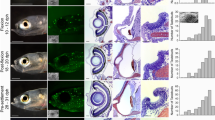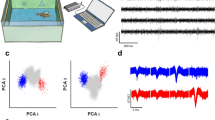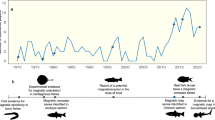Abstract
We studied the orientation of plaice (Pleuronectes platessa L.) in the open sea (Southern Bight of the North Sea) during May and June of 1979 and 1980, using continuous, on-line data from 6 fish equipped with transponding acoustic compass tags. During the day, fish swimming in midwater did not maintain their heading. At night, the same fish maintained their heading in a way that was consistent with active orientation to some external directional clue, but inconsistent with the use of an inertial guidance system. We believe this to be the first analysis to demonstrate the use of external guidance clues by fish in the open sea. Because fish were able to maintain a consistent heading in midwater by night, in the apparent absence of both visual and tactile clues, the external reference is likely to be geophysical. Possible clues include the electrical field generated by the flow of sea water through the geomagnetic field and the earth's magnetic field itself.
Similar content being viewed by others
References
Anonymous (1972). The Decca navigator system. Operating instructions and marine data sheets. The Decca Navigator Co., London
Arnold, G. P. (1974). Rheotropism in fishes. Biol. Rev. 49: 515–576
Arnold, G. P., Cook, P. H. (1984). Fish migration by selective tidal stream transport: first results with a computer simulation model for the European continental shelf. In: McCleave, J. D., Arnold, G. P., Dodson, J. J., Neill, W. H. (eds.) Mechanisms of migration in fishes. Plenum Press, New York, London, p. 227–261
Arnold, G. P., Greer Walker, M., Holford, B. H. (1990). Fish behaviour: achievements and potential of high-resolution sector-scanning sonar. Rapp. P.-v. Réun. Cons. perm. int. Explor. Mer. 189: 112–122
Arnold, G. P., Metcalfe, J. D. (1989). Acoustic telemetry: progress and potential in understanding fish behaviour. Proceedings of the Institute of Acoustics. Vol 11. Pt 3. Progress in fisheries acoustics. Institute of Acoustics, Bath, England, p. 96–103
Baker, R. R. (1980) Goal orientation by blindfold humans after long-distance displacements: possible involvement of a magnetic sense. Science, N.Y. 210: 555–557
Barber, N., Longuet-Higgins, M. S. (1948). Water movements and earth currents: electrical and magnetic effects. Nature, Lond. 161: 192–193
Benhamou, S. Bovet, P. (1992). Distinction between elementary orientation mechanisms by means of path analysis. Anim. Behav. 43: 371–377
Berge, J. A. (1979). The perception of weak electric A.C. currents by the European eel Anguilla anguilla. Comp. Biochem. Physiol. 62A: 915–920
Blakemore, R. (1975). Magnetotactic bacteria. Science, N.Y. 190: 377–379
Bovet, P., Benhamou, S. (1988). Spatial analysis of animals' movements using a correlated random walk model. J. theor. Biol. 131: 419–433
Buckley, A. A. (1993). Open sea fish tracks: plaice fitted with compass tags. Fish Res. Data Rep., Fish. Lab., Lowestoft, Suffolk 35: (in press)
Carey, F. G., Scharold, J. V. (1990). Movements of blue sharks (Prionace glauca) in depth and course. Mar. Biol. 106: 329–342
Croy, M. I., Hughes, R. N. (1991). Hierarchical response to prey stimuli and associated effects of hunger and foraging experience in the fifteen-spined stickleback, Spinachia spinachia (L.). J. Fish Biol. 38: 599–607
Dawkins, R. (1976). Hierarchical organisation: a candidate principle for ethology. In: Bateson, P. P. G., Hinde, R. A. (eds.) Growing points in ethology. Cambridge University Press, Cambridge, p. 7–54
Defant, A. (1958). Ebb and flow. The University of Michigan Press, Ann Arbor, Michigan, USA
Doucet, P. G., Drost, N. J. (1985). Theoretical studies on animal orientation II. Directional displacement in kineses. J. theor. Biol. 117: 337–361
Faraday, M. (1832). Experimental researches in electricity. Phil. Trans. R. Soc. 122: 125–194
Greer Walker, M., Harden Jones, F. R., Arnold, G. P. (1978). The movements of plaice (Pleuronectes platessa) tracked in the open sea. J. Cons. int. Explor. Mer 38: 58–86
Griffin, D. R. (1955). Bird navigation. In: Watson, A. (ed.) Recent studies in avian biology, University of Illinois Press, Urbana, p 154–197
Harden Jones, F. R. (1981). Fish migration: strategy, and tactics. Semin. Ser. Soc. exp. Biol. 13: 139–165
Harden Jones, F. R. (1984a). A view from the ocean. In: McCleave, J. D., Arnold, G. P., Dodson, J. J., Neill, W. H. (eds.) Mechanisms of migration in fishes. Plenum Press, New York, London, p. 1–26
Harden Jones, F. R. (1984b). Could fish use inertial clues when on migration? In: McCleave, J. D., Arnold, G. P., Dodson, J. J., Neill, W. H. (eds.). Mechanisms of migration in fishes. Plenum Press, New York, London, p. 67–78
Harden Jones, F. R., Arnold, G. P. (1982). Acoustic telemetry and the marine fisheries. Symp. zool. Soc. Lond. 49: 75–93
Harden Jones, F. R., Arnold, G. P., Greer Walker M. (1979). Selective tidal stream transport and the migration of plaice (Pleuronectes platessa) in the southern North Sea. J. Cons. int. Explor. Mer 39: 331–337
Kalmijn, A. J. (1974). The detection of electric fields from inanimate and animate sources other than electric organs. In: Fessard, A. (ed.) Handbook of sensory physiology. Vol III 3. Electroreceptors and other specialised receptors in lower vertebrates. Springer-Verlag, Berlin, Heidelberg, New York, p. 147–200
Karlsen, H. E. (1992). Infrasound sensitivity in the plaice (Pleuronectes platessa) J. exp. Biol. 171: 173–187
Kirschvink, J. L., Walker, M. M., Chang, S.-B. R., Dizon, A. E., Peterson, K. A. (1985). Chains of single-domain magnetite particles in chinook salmon, Oncorhynchus tshawytscha. J. comp. Physiol. 157A: 375–381
Kleerekoper, H., Timms, A. M., Westlake, G. F., Davy, F. B., Malar, T., Anderson, V. M. (1969). Inertial guidance system in the orientation of the goldfish (Carassius auratus). Nature, Lond 223: 501–502
Kleerekoper, H., Timms, A. M., Westlake, G. F., Davy, F. B., Malar, T., Anderson, V. M. (1970). An analysis of locomotor behaviour of goldfish (Carassius auratus). Anim. Behav. 18: 317–330
Lawson, K. D., Carey, F. G. (1972). An acoustic telemetry system for transmitting body and water temperature from free swimming fish. Tech. Rep. Woods Hole oceanogr. Instn. WHOI-71-67 (unpublished manuscript)
Lindauer, M., Martin, H. (1972). Magnetic effect on dancing bees. In: Galler, S. R., Schmidt-Koenig, K., Jacobs, G. J., Belleville, R. E. (eds.) Animal orientation and navigation. Science and Technical Information Office, National Aeronautics and Space Administration, Washington D.C., p. 559–567
McCleave, J. D., Power, J. H. (1978). Influence of weak electric and magnetic fields on turning behaviour in elvers of the American eel Anguilla rostrata. Mar. Biol. 46: 29–34
McKeown, B. A. (1984). Fish migration. Croom Helm, London & Sydney
Metcalfe, J. D., Arnold, G. P., Webb, P. W. (1990). The energetics of selective tidal stream transport: an analysis for plaice tracked in the southern North Sea. J. mar. biol. Ass. U.K. 70: 149–162
Metcalfe, J. D., Fulcher, M., Storeton West, T. J. (1992). Progress and developments in telemetry for monitoring the migratory behaviour of plaice in the North Sea. Wildlife telemetry. Remote monitoring and tracking of animals. Ellis Horwood, New York, London, Toronto, Sydney, Tokyo, Singapore, p. 358–366
Mitson, R. B., Cook, J. C. (1971). Shipboard installation and trials of an electronic sector-scanning sonar. Radio electron. Engng 41: 339–350
Moore, A., Freake, S. M., Thomas, I. M. (1990). Magnetic particles in the lateral line of Atlantic salmon (Salmo salar L.) Phil. Trans. R. Soc. (Ser. B) 329: 11–15
Pals, N., Peters, R. C., Schoenhage, A. A. C. (1982). Local geo-electric fields at the bottom of the sea and their relevance for electrosensitive fish. Neth. J. Zool. 32: 479–494
Pearson, N. D., Storeton West, T. J. (1987). The design of an acoustic transponding compass tag for free-swimming fish. Proceedings of the IERE International Conference No. 72. Electronics for Ocean Technology. Institution of Electronic and Radio Engineers, London, p. 83–92
Perry, A., Bauer, G. B., Dizon, A. E. (1985). Magnetoreception and biomineralization of magnetite in amphibians and reptiles. In: Kirschvink, J. L., Jones, D. S., MacFadden, B. J. (eds.) Magnetite biomineralization and magnetoreception in organisms: a new biomagnetism. Plenum Press, New York, London, p. 439–453
Regnart, H. C. (1931). The lower limits of perception of electric currents by fish. J. mar. biol. Ass. U.K., 17: 415–420
Regnart, H. C. (1932). The generation of electric currents by water moving in a magnetic field. Proceedings of the Durham Philosophical Society. 8: 291–300
Rijnsdorp, A. D., Ibelings, B. (1989). Sexual dimorphism in the energetics of reproduction and growth of North Sea plaice, Pleuronectes platessa. J. Fish Biol., 35: 401–415
Rommel, S. A., McCleave, J. D. (1973). Sensitivity of American eels (Anguilla rostrata) and Atlantic salmon (Salmo salar) to weak electric and magnetic fields. J. Fish. Res. Bd Can. 30: 657–663
Saila, S. B., Shappy, R. A. (1963). Random movement and orientation in salmon migration. J. Cons. perm. int. Explor. Mer 28: 153–166
Sciarrotta, T. C., Nelson, D. R. (1977). Diel behaviour of the blue shark, Prionace glauca near Santa Catalina island, California. Fish. Bull. U.S. 75: 519–528
Smith, G. W., Hawkins, A. D., Urquhart, G. G., Shearer, W. H. (1981). Orientation and energetic efficiency in the offshore movements of returning Atlantic salmon Salmo salar L. Scott. Fish. Res. Rep. 21: 1–22
Smith, R. J. F. (1985). The control of fish migration. Springer-Verlag, Berlin, Heidelberg, New York, Tokyo
Steele, C. W. (1989). Evidence for the use of continuous angle compensation as a mechanism for inertial guidance by sea catfish Arius felis. Am. Midl. Nat. 122: 183–192
Tesch, F.-W. (1974). Speed and direction of silver and yellow eels, Anguilla anguilla, released and tracked in the open North Sea. Ber. dt. wiss. Kommn Meeresforsch. 23: 181–197
Tinbergen, N. (1950). The hierarchical organisation of nervous mechanisms underlying instinctive behaviour. Symp. Soc. exp. Biol. 4: 305–312
Veen, de, J. F. (1970). On the orientation of the plaice (Pleuronectes platessa L.) I. evidence for orientating factors derived from the ICES transplantation experiments in the years 1904–1909. J. Cons. int. Explor. Mer 33: 192–227
Walker, M. M., Kirschvink, J. L., Chang, S.-B. R., Dizon, A. E. (1984). A candidate magnetoreceptor organ in the yellowfin tuna, Thunnus albacares. Science, N.Y. 224: 751–753
Walcott, C., Green, R. P. (1974). Orientation of homing pigeons altered by a change in the direction of an applied magnetic field. Science, N.Y. 184: p. 180
Weihs, D. (1978). Tidal stream transport as an efficient method for migration. J. Cons. int. Explor. Mer 38: 92–99
Wilkinson, D. H. (1952). The random element in bird navigation. J. exp. Biol. 29: 532–560
Williams, B. (1992). The measurement of “sinuosity” in correlated random walks. J. theor. Biol. 155: 437–442
Author information
Authors and Affiliations
Additional information
Communicated by J. Mauchline, Oban
Rights and permissions
About this article
Cite this article
Metcalfe, J.D., Holford, B.H. & Arnold, G.P. Orientation of plaice (Pleuronectes platessa) in the open sea: evidence for the use of external directional clues. Marine Biology 117, 559–566 (1993). https://doi.org/10.1007/BF00349766
Received:
Accepted:
Issue Date:
DOI: https://doi.org/10.1007/BF00349766




